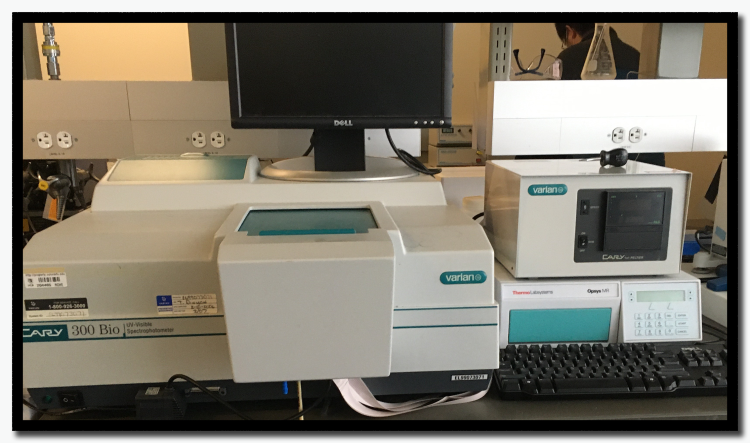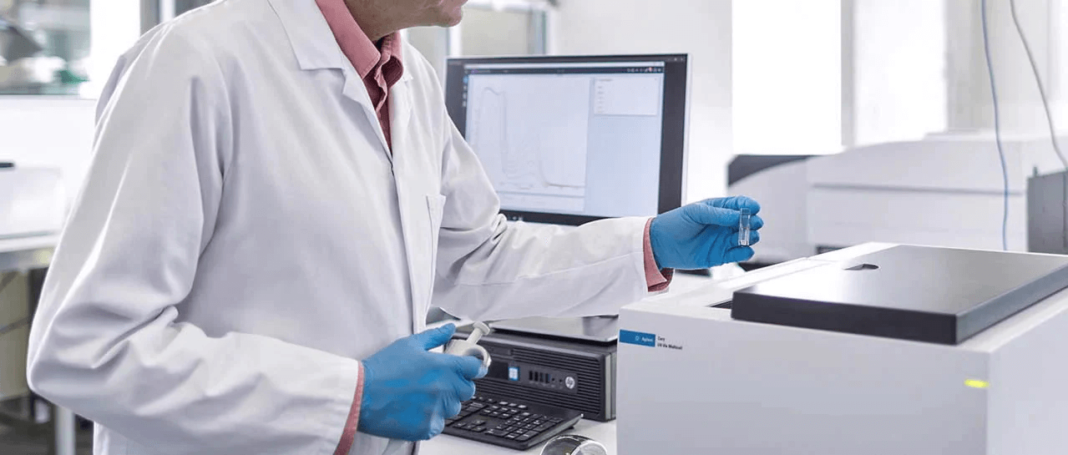The Agilent Uv-Vis Spectroscopy method is a technological development extensively utilized in varied areas of Science. It’s used for bacterial culturing, nucleic acid purity checks, drug identification, quantitation, and high quality management in chemical analysis and the beverage industries. This progressive know-how makes the lives of researchers and scientists simpler.
Let’s study Uv-Vis spectroscopy, the way it works, and its benefits and limitations.
What’s Uv-Vis Spectroscopy?
Uv-Vis Spectroscopy is a quantitative and analytical method that measures the quantity of seen or UV gentle a chemical substance absorbs by a Uv-Vis spectrometer. The method is finished by measuring gentle’s depth in wavelengths that passes by a specific pattern after which evaluating it with a clean or a reference pattern.
Typically, Uv-Vis Spectroscopy is extensively utilized in a number of pattern varieties: liquids, glass, and skinny movies. It’s a complicated method that sees past the seen gentle spectrum our eyes can see, together with ultraviolet and infrared gentle.
How does Uv-Vis Spectroscopy Work?
To provide you a greater understanding of how Uv-Vis spectroscopy works, let’s speak about its most important elements and the processes of how gentle is absorbed and measured by the spectrometer.
1. Parts and How They Perform

Although Uv-Vis spectrometers are available in varied types, all these machines can solely perform optimally when these elements are full and correctly working:
2. Lightsource
For a Uv-Vis spectrometer to work, a lightweight supply is important. One of the vital widespread high-intensity gentle sources used for seen and UV ranges is a xenon lamp. Nevertheless, it’s costlier and fewer steady in comparison with halogen and tungsten lamps. If a spectrometer wants two lamps, a halogen or a tungsten lamp is often used as seen gentle and a deuterium lamp because the UV gentle.
As a result of these are two totally different gentle sources, the spectrometer ought to change when measuring the sunshine’s depth. Typically, the switchover happens at 300 to 350 nanometers, when the sunshine emission is similar for each the seen and UV gentle sources, permitting smoother transition.
3. Wavelength Selector
Wavelength choice is finished to find out which wavelength is suited to the kind of analyte and pattern to permit pattern examination from the wavelengths the sunshine supply emits. Probably the most extensively used selector in Uv-Vis spectrometer is the monochromator, and this accommodates the next elements:
- Entrance slit
- Collimating lens
- Dispersing gadget, generally a grating or a prism
- Focusing lens
- Exit slit
Polychromatic radiation or radiation of a number of wavelengths will enter the monochromator from the doorway slit. The beam will collimate and strike the dispersing component by a particular angle and cut up into a number of part wavelengths utilizing the prism or the grating. Single radiation of a particular wavelength will depart the monochromator by way of the exit slit.
Some Uv-Vis spectrometers use monochromators and filters to slim gentle wavelengths, permitting extra exact measurements and enhancing the signal-to-noise ratio.
4. Pattern Container
The pattern container and reference options ought to be clear in comparison with the radiation passing by. Fused silica or quartz cuvettes are generally used for spectroscopy in each UV and visual areas.
5. Detectors
The most typical detector utilized in Uv-Vis spectroscopy is the photomultiplier tube, which accommodates a photoemissive cathode, dynodes, and an anode. A photoemissive cathode emits electrons when it’s struck by radiation photons, whereas the dynodes emit a number of electrons every time an electron strikes them.
When a radiation photon enters the tube, it strikes the cathode, which is able to emit a number of electrons. The emitted electrons will speed up and strike the primary dynode, which is able to emit extra electrons as every incident electron strikes it. Once more, the electrons emitted will speed up to the second dynode, repeating the method till the electrons attain the anode.
As soon as the electrons attain the anode, the photon from the start of the method has already produced tens of millions of electrons, and the ensuing present will probably be measured and amplified.
The Goal and Purposes of Uv-Vis Spectroscopy

Uv-Vis Spectroscopy has been extensively utilized in varied pattern testing at this time. This method has the next well-known progressive purposes:
1. RNA and DNA Evaluation
One of the vital widespread purposes of the spectrometer is verifying the RNA or DNA purity and focus. The Uv-Vis spectroscopy ensures that the DNA or RNA samples ready for sequencing or different purposes usually are not contaminated with any chemical compounds that might negatively have an effect on the outcomes.
2. Pharmaceutical Evaluation
The mathematical derivatives of a Uv-Vis spectrometer have been an efficient machine to detect particular person pharmaceutical compounds in overlapping absorbance peaks or totally different powder formulations.
3. Bacterial Tradition
Uv-Vis spectroscopy can be extensively utilized in culturing micro organism, estimating their cell concentrations, and monitoring their progress. The wavelength measurement generally used is 600 nm to protect the bacterial tradition media properties and the cells when they’re wanted for consecutive and steady experimentation.
4. Beverage Evaluation
Uv-Vis spectroscopy has additionally successfully recognized the quantitative content material of sure compounds in varied drinks, similar to caffeine content material and coloured substances like anthocyanin in wine.
5. Different Purposes
Uv-Vis spectroscopy has confirmed its success and effectivity in varied different purposes, together with the next:
- Meals and agriculture
- Beauty business
- Petrochemistry
- Materials Science
- High quality Management
- Astrology
Benefits of Uv-Vis Spectroscopy
The very best benefit of using Uv-Vis spectrometers is their optimum accuracy. These machines are assured to present you correct readings, that are important when it’s essential to put together chemical options or report the motion of the celestial our bodies.
Uv-Vis spectroscopy can be straightforward to know with its easy evaluation capacity. The spectrometers are handy and straightforward to function, and there’s solely a uncommon probability that you’re going to get the readings improper.
Disadvantages of Uv-Vis Spectroscopy
The principle drawback of Uv-Vis spectrometers is their difficult meeting, and it could take time to arrange utilizing them. Be certain that the realm the place you’ll place the gadget is evident of any digital noise, exterior gentle, and different contaminants that might have an effect on the measurements and readings of the spectrometer.
A Uv-Vis spectrometer is delicate to exterior elements, so you could guarantee your working space is clear and dust-free. Except for that, the gadget’s stray gentle brought on by a defective gear design may additionally affect the accuracy of the machine’s measurement. It is because stray gentle will doubtless cut back the linearity vary and substance absorbency it’s measuring.
Uv-Vis Spectroscopy Limitations
Even a complicated method like Uv-Vis spectroscopy has limitations, too. You may grasp what these are under:
1. Pattern
Whereas this method works properly with liquids and different options, the readings might not be as correct when the pattern is a suspension of various strong particles. The pattern will doubtless scatter the sunshine slightly than take in it with solids, affecting the information. Typically, UV-vis spectrometers are extra environment friendly in analyzing liquids and options.
2. Selection of The Solvent or Container
When selecting what solvent to make use of, be certain that its absorbance cutoff will not be near the pattern or compound to be examined. Except for the solvent, the fabric of the container or cuvette can be essential as a result of it additionally has a UV-vis absorbance cutoff. Typically, a quartz container or cuvette is more practical and sensible as a result of its absorbance cutoff is simply round 160 nm.
3. Reference and Calibration
Calibration references used to match the pattern readings ought to be precisely ready to find out the pattern’s focus to be examined.
UV-Vis Spectroscopy is the Future

UV-vis spectroscopy supplies researchers and scientists with extra environment friendly strategies to measure gentle wavelengths, offering correct readings which are useful in varied organic and chemical analyses.
The UV-vis spectrometer gadget is exact and straightforward to function, supplied that you simply preserve a clear working space free from any exterior noise and mud that may have an effect on the machine’s readings.

